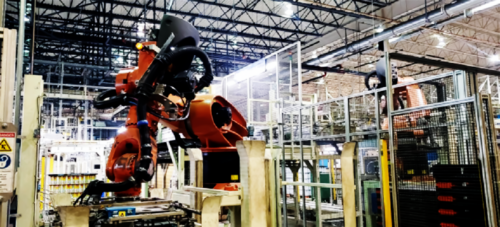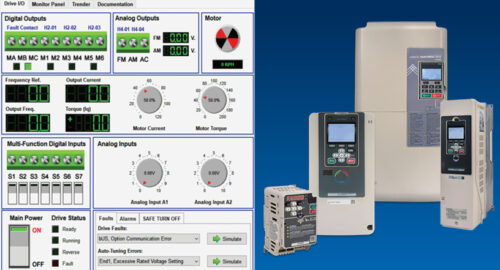Nuclear Supplier Upgrades Controls Increasing Efficiency, Production
What to keep and what to replace were among decisions made during a major control system upgrade at a large supplier to the nuclear-power industry. Empresa Neuquina de Servicios de Ingeniería S.E. (ENSI) operates the industrial heavy-water plant—owned by the Argentine National Atomic Energy Commission—selling 200 metric-tons/year of reactor-degree virgin heavy water, a strategi...
AT A GLANCE
System upgrade
HMI Web-based graphics
Database conversion
What to keep and what to replace were among decisions made during a major control system upgrade at a large supplier to the nuclear-power industry.
Empresa Neuquina de Servicios de Ingeniería S.E. (ENSI) operates the industrial heavy-water plant—owned by the Argentine National Atomic Energy Commission—selling 200 metric-tons/year of reactor-degree virgin heavy water, a strategic product for natural-uranium-fueled nuclear-power plants. Built in 1989, at Arroyito, Neuquen Province, Argentina, the heavy water plant is unique in Latin America. Centrally located in Argentina’s power generation grid, the 50-acre facility consumes about 81 MW, equivalent to a medium-sized city’s demand. The operation comprises 300 pumps, 250 heat exchangers, 240 pressure vessels, 90 gas compressors, 13 reactors, 30 distillation columns, 8 furnaces, and more than 500 electric motors, among others. Additionally, the plant has a pair of ammonia-synthesis reactors with a 4,500 metric-ton/day total capacity.
In its early years, the plant’s objective was to supply local nuclear power plants. Since then, ENSI’s commercial scope has expanded, successfully penetrating the Asian, European, and North American markets. The plant is recognized as the world’s largest.
To improve plant performance, the company revamped distributed control systems (DCS), programmable logic controllers (PLC), and control panels. ENSI selected Real Time Service S.A. (RTS) and Honeywell Argentina to upgrade its DCS from Honeywell’s Total Plant Solution (TPS) to its Experion Process Knowledge System Release 201. Various technical challenges were encountered. Some required use of engineering best practices; in others, lessons were learned.
Project scope
The TPS system was installed in the late-’90s as part of a plant upgrade. And a third-party DCS had to be migrated. Base engineering and configuration were provided by Honeywell Argentina, while ENSI’s staff oversaw the migration process. The system comprised 6 high-performance controllers; 2,300 physical I/O points; 2,000 serial I/O data points; and 12 global universal stations. Since then, no major improvements to the control system had been undertaken.
With Argentina’s increasing demand for electricity, several nuclear-power plant projects were begun. This drove the need for improving plant performance. The upgrade focused on operational efficiency, system interconnectivity, and future expansion. Display and alarm standardization was a key element. Since the human machine interfaces (HMI) had been designed by ENSI’s operators, most displays were highly populated and, while their performance was less than ideal, they were functional.
System interconnectivity was a special issue, since a parallel project for upgrading the compressors’ PLCs—for equipment health monitoring—had already started—so compatibility of ControlNet communications to Rockwell PLCs and Rockwell Entek Supervisory Assets System was mandatory.
ENSI decided on a turnkey project to upgrade the existing TPS system to Experion PKS R201 for reasons including promise of a smooth migration. For the project:
New system architecture contains pre-existing DCS I/O boards, so ENSI did not need to change the whole control system for the upgrade. Reuse was possible without completely altering plant wiring and I/O boards. Control processors were changed and open control-and-supervisory networks and a redundant Experion Server were added.
Z-type components—including monitors, trackballs, and keyboards—for operation and engineering stations were reused.
Most control functions of the HPM controllers are also implemented in C200 controllers; the plant simply replicated previous system configuration using the new engineering tools—dramatically reducing plant downtime and engineering effort.
Honeywell uses Abnormal Situation Management (ASM) Consortium recommendations for operation displays, easing the rebuild of plant displays.
For system expansion and maintenance, Experion implements workstations via commercial hardware, reducing costs for off-the-shelf hardware.
Honeywell Argentina provided core software- and hardware-assembly-services at its Buenos Aires facility. RTS, a Honeywell Argentina-authorized systems integrator, provided database conversion, configuration services for the C200 controllers, HMI Web-based graphics-development, and serial-device communication configuration. Additionally, Honeywell sub-contracted Argentina RTS for on-site installation assistance, operator and maintenance training, and field start-up support.
The migration followed a total replacement approach at hardware and software levels. A phased migration was not considered cost-effective because no major upgrades had been made in the control system since installation. Also, on-site work could be carried out while the production lines were stopped; so hot cutover was not an issue.
The supplied system was composed of redundant Experion PKS servers. In the control layer, six pairs of redundant C200 controllers—with PMIO IOLinks and one serial interface module—replaced the HPM controllers. ControlNet was selected as the supervisory network. A fiber-optic adapter-and-repeater was installed at every controller to use existing fiber-optic wiring. Global user stations were replaced by six multi-window Flex Stations, five single-window Flex Stations, and two engineering workstations. Additionally, one Experion PKS e-Server was included in the information network to provide process-data access for the business layer.
Database conversion
Honeywell and ENSI had configured the former TPS Database, containing about 4,000 points. Database conversion began by classifying every loop in a set of typical control strategies, such as indicators with alarming, simple PID loops, split-range loops, two-controllers cascade loops, and pump controls. RTS and ENSI staff completed the task—resulting in the start point of the Experion database configuration. RTS then translated typical TPS strategies into Experion templates. This template also contributed to the standardization of the database, yielding a base language for documentation and maintenance by the ENSI staff.
There’s no one-to-one equivalence between systems, so, to prevent database incompatibilities, TPS and Experion engineers developed a translation table to map point types, function blocks, and parameters used in the typical templates.
Some complex TPS strategies were resolved in a simpler, more elegant fashion in Experion, since Experion function blocks are usually more versatile. For instance, Experion’s Device Control function block incorporates device statistics, such as run hours and number of transitions; in TPS this was accomplished in separate points. Moreover, most control function blocks in Experion have several interlock options, where a dedicated logic should be configured in TPS.
On the other hand, Experion did not support some TPS functions—the PID with external feedback reset algorithm, for example. There were also special situations; logic points in TPS can hold different logic circuits used by completely different control strategies. Engineers analyzed each point to decide which Experion point should contain the logics.
Once templates were defined and translation tables were ready, the Experion database creation started. By using templates and translation tables, automatic configuration from the TPS database to the Experion database ensured data integrity, as well as a means of controlling and documenting the process.
HMI Web-display upgrade
ENSI’s operation staff designed the TPS visualization system using Honeywell GUS Display Builder; most of the 100 custom displays had dense graphics and were highly populated. Use of embedded sub-pictures did not allow application of an automatic tool for converting these displays. Additionally, ENSI wanted to follow the Abnormal Situation Management (ASM) guidelines to increase operational effectiveness. Therefore, TPS and Experion specialists developed a display-conversion strategy.
First, to give ENSI’s staff the chance to suggest changes, a conversion of the static portion of each display was built in Experion’s HMI Web Display Builder. Style sheets proved to be extremely helpful, since they enabled changes to aesthetical aspects of the displays, such as colors, fonts and line types, without having to redraw all displays.
Meanwhile, dynamic objects were selected from the ASM library. As expected, many animated shapes had functionality that did not exist in TPS displays, such as automatic faceplates and alarming indicators.
Conversely, new shapes and faceplates had to be developed in special cases. For example, all data from and to the serial interface were implemented in TPS as numeric- or flag-arrays; sub-pictures may accept indices of these arrays as parameters, so no extra database points are needed to show serial data in a display. In Experion, dynamic shapes may not pass an index as a parameter, since the index should be part of the specified parameter, and that forced Experion engineers to create additional points to manage this situation.
Once displays were ready and approved and database conversion was complete, the database linking process took place. The selected approach was to follow the typical templates classification used in the database conversion. This helped in the internal display validation process, but it might have delayed ENSI’s display validation, as displays were not finished until the last template was linked.
PMIO IOLinks allowed use of existing TPS-system I/O modules, so no instrumentation wires in the I/O racks had to be left during installation. Thus, there was no need to check control loops on every I/O connection; only limited testing (per I/O card) was carried out to ensure proper interconnection. The same applied to serial communications, since the new serial interface module was connected to the old Honeywell FTA (modules), and no communication wires were replaced.
The database and displays were available for the operations and maintenance staff prior to the start-up, allowing performance of an in-depth test of the entire system and improving operator-training levels. As expected, the transition between TPS and Experion was smooth, with no major troubles beyond normal startup issues.
Parting advice
Expertise in TPS and the Experion system is needed for a successful migration. While automatic migration is possible, an investigation should be made to identify special cases in which systems are completely different. Also, this project showed that rigorous planning in every aspect of database- and display-conversion is fundamental. Use of ASM guidelines helped in display standardization and system performance.
All at once
A noteworthy advantage in this total replacement approach is that all the work is done once. The phased migration option usually starts with the visualization system, so displays are converted to HMI Web. Later, when the hardware layer is replaced and database is converted, displays are likely to be reconverted to take advantage of Experion capabilities that TPS lacks.
PMIO integration was shown to be critical to avoid I/O rewiring and ease commissioning and start-up tasks, reducing their complexity. A plus was the early availability of the database and displays to the customer.
ENSI expects this upgrade will underpin and foster greater functionalities, such as advanced control and information management.
Author Information
Edgardo Ferro, Ph.D., is at Universidad Nacional del Sur; Martin Bolino, electrical and instrumentation maintenance manager, and Ruben Carzoglio, senior system engineer, are Empresa Neuquina de Servicios de Ingeniería S.E. (ENSI);
Do you have experience and expertise with the topics mentioned in this content? You should consider contributing to our CFE Media editorial team and getting the recognition you and your company deserve. Click here to start this process.





